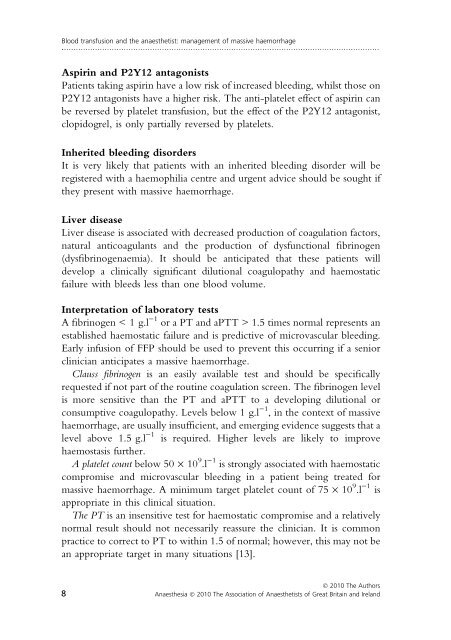Blood transfusion and the anaesthetist: management of ... - aagbi
Blood transfusion and the anaesthetist: management of ... - aagbi
Blood transfusion and the anaesthetist: management of ... - aagbi
Create successful ePaper yourself
Turn your PDF publications into a flip-book with our unique Google optimized e-Paper software.
<strong>Blood</strong> <strong>transfusion</strong> <strong>and</strong> <strong>the</strong> anaes<strong>the</strong>tist: <strong>management</strong> <strong>of</strong> massive haemorrhage<br />
.....................................................................................................................................<br />
Aspirin <strong>and</strong> P2Y12 antagonists<br />
Patients taking aspirin have a low risk <strong>of</strong> increased bleeding, whilst those on<br />
P2Y12 antagonists have a higher risk. The anti-platelet effect <strong>of</strong> aspirin can<br />
be reversed by platelet <strong>transfusion</strong>, but <strong>the</strong> effect <strong>of</strong> <strong>the</strong> P2Y12 antagonist,<br />
clopidogrel, is only partially reversed by platelets.<br />
Inherited bleeding disorders<br />
It is very likely that patients with an inherited bleeding disorder will be<br />
registered with a haemophilia centre <strong>and</strong> urgent advice should be sought if<br />
<strong>the</strong>y present with massive haemorrhage.<br />
Liver disease<br />
Liver disease is associated with decreased production <strong>of</strong> coagulation factors,<br />
natural anticoagulants <strong>and</strong> <strong>the</strong> production <strong>of</strong> dysfunctional fibrinogen<br />
(dysfibrinogenaemia). It should be anticipated that <strong>the</strong>se patients will<br />
develop a clinically significant dilutional coagulopathy <strong>and</strong> haemostatic<br />
failure with bleeds less than one blood volume.<br />
Interpretation <strong>of</strong> laboratory tests<br />
A fibrinogen < 1 g.l )1 or a PT <strong>and</strong> aPTT > 1.5 times normal represents an<br />
established haemostatic failure <strong>and</strong> is predictive <strong>of</strong> microvascular bleeding.<br />
Early infusion <strong>of</strong> FFP should be used to prevent this occurring if a senior<br />
clinician anticipates a massive haemorrhage.<br />
Clauss fibrinogen is an easily available test <strong>and</strong> should be specifically<br />
requested if not part <strong>of</strong> <strong>the</strong> routine coagulation screen. The fibrinogen level<br />
is more sensitive than <strong>the</strong> PT <strong>and</strong> aPTT to a developing dilutional or<br />
consumptive coagulopathy. Levels below 1 g.l )1 , in <strong>the</strong> context <strong>of</strong> massive<br />
haemorrhage, are usually insufficient, <strong>and</strong> emerging evidence suggests that a<br />
level above 1.5 g.l )1 is required. Higher levels are likely to improve<br />
haemostasis fur<strong>the</strong>r.<br />
A platelet count below 50 · 10 9 .l )1 is strongly associated with haemostatic<br />
compromise <strong>and</strong> microvascular bleeding in a patient being treated for<br />
massive haemorrhage. A minimum target platelet count <strong>of</strong> 75 · 10 9 .l )1 is<br />
appropriate in this clinical situation.<br />
The PT is an insensitive test for haemostatic compromise <strong>and</strong> a relatively<br />
normal result should not necessarily reassure <strong>the</strong> clinician. It is common<br />
practice to correct to PT to within 1.5 <strong>of</strong> normal; however, this may not be<br />
an appropriate target in many situations [13].<br />
Ó 2010 The Authors<br />
8 Anaes<strong>the</strong>sia Ó 2010 The Association <strong>of</strong> Anaes<strong>the</strong>tists <strong>of</strong> Great Britain <strong>and</strong> Irel<strong>and</strong>

















